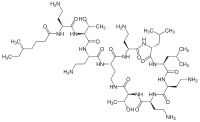
Photo from wikipedia
Neurotoxicity is one major unwanted side-effects associated with polymyxin (i.e., colistin and polymyxin B) therapy. Clinically, colistin neurotoxicity is characterized by neurological symptoms including dizziness, visual disturbances, vertigo, confusion, hallucinations,… Click to show full abstract
Neurotoxicity is one major unwanted side-effects associated with polymyxin (i.e., colistin and polymyxin B) therapy. Clinically, colistin neurotoxicity is characterized by neurological symptoms including dizziness, visual disturbances, vertigo, confusion, hallucinations, seizures, ataxia, and facial and peripheral paresthesias. Pathologically, colistin-induced neurotoxicity is characterized by cell injury and death in neuronal cell. This Review covers our current understanding of polymyxin-induced neurotoxicity, its underlying mechanisms, and the discovery of novel neuroprotective agents to limit this neurotoxicity. In recent years, an increasing body of literature supports the notion that polymyxin-induced nerve damage is largely related to oxidative stress and mitochondrial dysfunction. P53, PI3K/Akt, and MAPK pathways are also involved in colistin-induced neuronal cell death. The activation of the redox homeostasis pathways such as Nrf2/HO-1 and autophagy have also been shown to play protective roles against polymyxin-induced neurotoxicity. These pathways have been demonstrated to be upregulated by neuroprotective agents including curcumin, rapamycin and minocycline. Further research is needed toward the development of novel polymyxin formulations in combination with neuroprotective agents to ameliorate this unwanted adverse effect during polymyxins therapy in patients.
Journal Title: ACS chemical neuroscience
Year Published: 2019
Link to full text (if available)
Share on Social Media: Sign Up to like & get
recommendations!